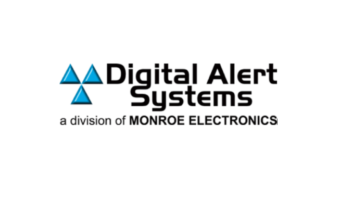Ohio’s 12 public television stations recently collaborated to provide a major upgrade to the state’s EAS system. The project seeks to provide IP-based redundancy for the existing alerting architecture that distributes messages to radio stations, TV stations and government alerting sites — but without involving the “last-mile” internet.

The service became operational at the end of last year; it debuted by delivering non-broadcast, Common Alerting Protocol-based state and federal alerting messages — via data embedded in public TV broadcasts — to existing EAS decoders at 26 Local Primary radio stations.
Ohio already had a working EAS system, so why the addition? David Carwile, OEAS project manager, explains the forces behind these recent changes:
“Our concerns with the existing EAS service began about 10 years ago, when FEMA decided to create a new emergency system that would rely almost solely on the internet to send critical information to the people who then distribute it to the public. It seemed like putting all your eggs in one basket. Those fears were borne out by subsequent events.”
Carwile mentioned a bridge collapse in Minneapolis, a private plane crash into an apartment building in New York City and Hurricane Sandy as instances when internet congestion or loss of physical infrastructure made communication virtually impossible. “As Hurricane Sandy demonstrated, when every other system went down, it was broadcasters that were still able to provide information to the public to ensure their safety.”
REDUNDANT BACKBONE
Ohio’s new OEAS Public AlertNet System is an “overlay” that can provide redundant, data-based delivery of EAS, CAP/IPAWS, weather and other emergency communications to any Ohio radio and TV station that participates in EAS. It does not replace existing EAS gear or create new alerting programs; rather it is an alternative way of delivering existing messages, aggregating them into a single data stream for ATSC broadcast.
To make this possible, the dozen stations in Ohio Educational Television Stations Inc. agreed to dedicate a portion of their broadcast bandwidth; but for many years, this was still a solution waiting to be funded. The financial dam broke in 2014, when the Corporation for Public Broadcasting created the Emergency Alerting and Communications grant program. Carwile submitted a proposal that eventually brought in $336,000. Among other things, those funds covered the cost of receivers for LP-1, -2 and -3 stations that serve the various EAS operational areas (though any broadcaster that distributes EAS can purchase a receiver system).
“The project, by its very nature, had to be a partnership, so we built it on the relationships we had been developing over the previous 10 years of discussions,” he said.

The Broadcast Educational Media Commission, a state agency, provides Ohio public TV stations with access to its existing secure state fiber interconnection, at no direct cost to them. It also allows OEAS to focus what goes into the system and define distribution to a set geographical area, in this case the state, which in turn allows them to include more “local content” in the available bandwidth.
Another key player is the Ohio Emergency Management Agency. EMA’s desire for an alternative delivery path for EAS and IPAWS was what the new system was intended to fulfill. But EMA also guaranteed sustainability by agreeing to host it as part of the overall state EAS system. TV stations assist but do not manage the system; final decisions are made by professionals in emergency management. The proponents at Ohio EMA were Dave Ford and Mike Swaney.
Carwile cited a number of other supporters. “The Ohio Association of Broadcasters, the State Emergency Communications Committee, Amber Alerts, Silver Alerts and the association representing the state’s 88 county EMAs have all endorsed the project. When the grant was awarded, we didn’t have any convincing to do.”
SCALABLE
The system uses technology from manufacturer Digital Alert Systems, part of Monroe Electronics. The core is a Digital Alert Systems emergency operations center, or DASEOC, that can originate and translate legacy EAS and relay CAP alerts, while a DASDEC-II EAS encoder/decoder functions as the message aggregator.
Next in the chain is a Triveni Digital SkyScraper digital content distribution system. The origination equipment resides at the state EMA headquarters in Columbus. The Broadcast Educational Media Commission hub receives and feeds the messaging over secure fiber connecting to the 12 digital transmitters operated by the OEAS member stations.

The 50 Ohio LP station and EMA agency sites with OEAS equipment have conventional EAS boxes that can receive data in FEMA’s Integrated Public Alert and Warning Format. To do this, the ATSC receivers at each site must be connected to emergency content servers equipped with IPAWS emulation software. The local EAS units poll the local server over their internal network, the same way they poll the IPAWS servers.
Everything starts at the Ohio EMA emergency operations center in Columbus. Here, IPAWS CAP messages are created or received and legacy EAS are translated. All messages are input to DASEOC, which authenticates, attaches a Spanish translation and relays them to the aggregator, where they are assembled into a single data stream. DASEOC can also process federal, state and county messages that need to get to first responders, a function now being offered to state agencies with a look forward to the new FirstNet system.
Next, the Triveni Digital SkyScraper encapsulates the data stream into a unique DTV transport stream. It is then delivered to the Broadcast Educational Media Commission Hub and on to the Ohio Educational Television Stations Master Control rooms over Ohio’s secure fiber network. Once the data stream is received at each public broadcast location, it is multiplexed into each station’s digital broadcast signal. The signal coverage of Ohio’s PBS stations essentially blankets all broadcast and cable facilities in the state, as well as public safety agencies.

Once the signals have been broadcast over HDTV, they are picked up by receivers at the state’s legacy EAS LP radio stations and at selected county EMA offices. The system can be expanded by equipping other agencies with the same digital TV data receivers, which have been integrated with Monroe Electronics’ DASLC emergency content management servers and IPAWS emulation modules.
TEMPLATE?
The public TV stations and the OEMA feel they have created a cutting-edge EAS system for Ohio and that perhaps it will serve as a template for other states contemplating updates to enhance last-mile redundancy in their systems.
The suppliers that helped build the system say that its “content-agnostic” architecture can transport any type of digital content securely, including non-public data and live video messaging. They say this will allow first responders and other emergency officials to use it as well, with information platforms of their choice.
Several inquiries have been received. “Broadcasters in other states can just as easily create a redundant EAS communications system or encrypted messaging to first responders,” said Carwile. “North Carolina and California are already in the process of adapting the technology in their states, and we’ve also been visited by some of the commercial television groups here in Ohio. They’re interested in purchasing the receiver packages so they can monitor the system directly. Those packages are available through Digital Alert Systems.”
More legacy messaging sources are being added to the multilingual overlay system, with audio translations in the works.
In fact, a system like OEAS is always a work in progress. Though it has just rolled out, Carwile already is planning the next round of upgrades.
“Specifically, we’re looking at enhanced weather, with video and rich media for Amber Alerts. This should create more of a demand from the TV side. All of these things should also be possible when ATSC 3.0 and an advanced alerting system comes online. Right now, though, most of our attention is focused on how our existing system can support the LTE-based FirstNet first-responder system that AT&T is developing for national use.”
Tom Vernon recently profiled John Kean, the 2017 recipient of the NAB Radio Engineering Achievement Award, for Radio World.












